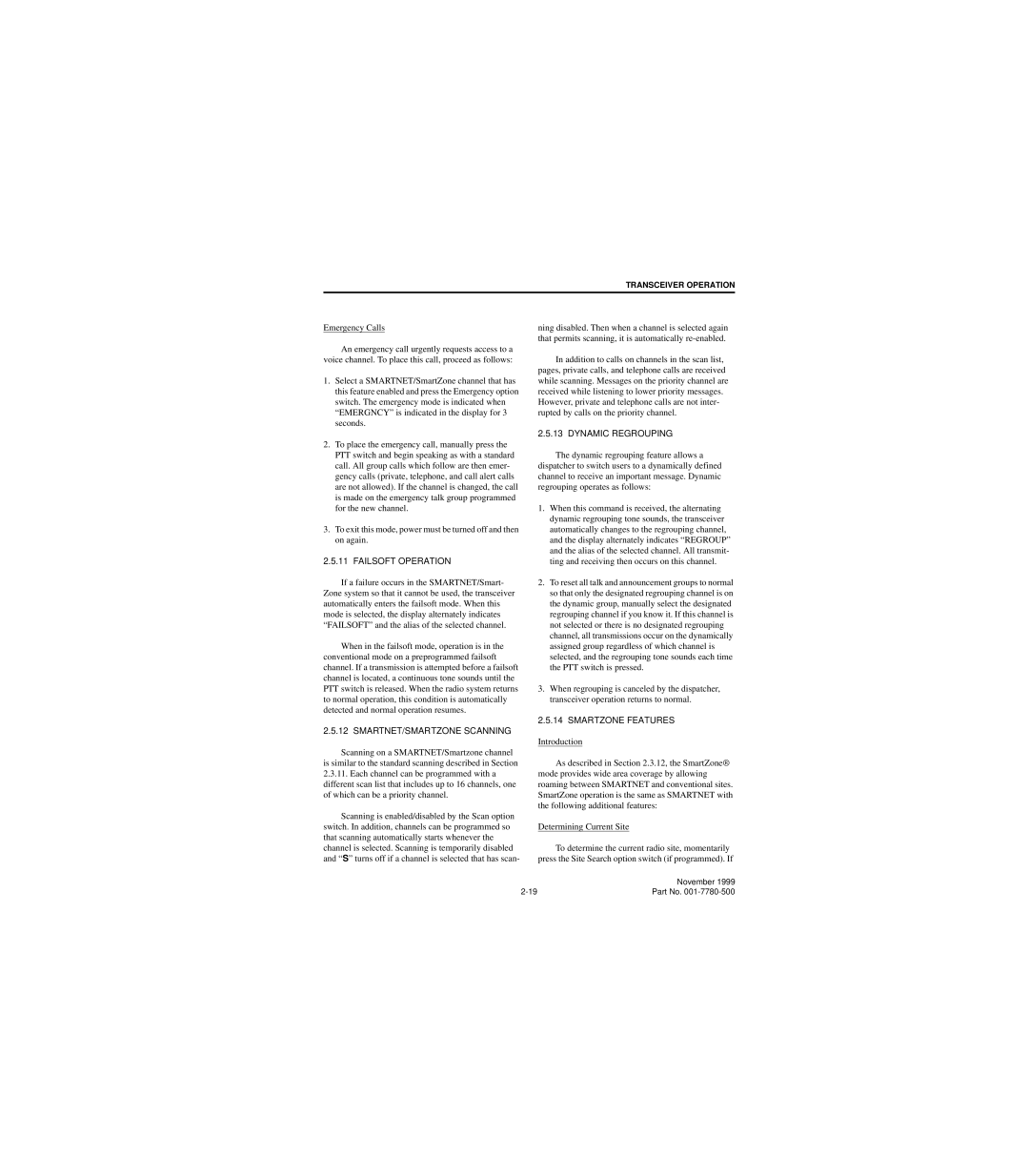TRANSCEIVER OPERATION
Emergency Calls
An emergency call urgently requests access to a voice channel. To place this call, proceed as follows:
1.Select a SMARTNET/SmartZone channel that has this feature enabled and press the Emergency option switch. The emergency mode is indicated when “EMERGNCY” is indicated in the display for 3 seconds.
2.To place the emergency call, manually press the PTT switch and begin speaking as with a standard call. All group calls which follow are then emer- gency calls (private, telephone, and call alert calls are not allowed). If the channel is changed, the call is made on the emergency talk group programmed for the new channel.
3.To exit this mode, power must be turned off and then on again.
2.5.11 FAILSOFT OPERATION
If a failure occurs in the SMARTNET/Smart- Zone system so that it cannot be used, the transceiver automatically enters the failsoft mode. When this mode is selected, the display alternately indicates “FAILSOFT” and the alias of the selected channel.
When in the failsoft mode, operation is in the conventional mode on a preprogrammed failsoft channel. If a transmission is attempted before a failsoft channel is located, a continuous tone sounds until the PTT switch is released. When the radio system returns to normal operation, this condition is automatically detected and normal operation resumes.
2.5.12 SMARTNET/SMARTZONE SCANNING
Scanning on a SMARTNET/Smartzone channel is similar to the standard scanning described in Section
2.3.11.Each channel can be programmed with a different scan list that includes up to 16 channels, one of which can be a priority channel.
Scanning is enabled/disabled by the Scan option switch. In addition, channels can be programmed so that scanning automatically starts whenever the channel is selected. Scanning is temporarily disabled and “ S” turns off if a channel is selected that has scan-
ning disabled. Then when a channel is selected again that permits scanning, it is automatically
In addition to calls on channels in the scan list, pages, private calls, and telephone calls are received while scanning. Messages on the priority channel are received while listening to lower priority messages.
However, private and telephone calls are not inter- rupted by calls on the priority channel.
2.5.13 DYNAMIC REGROUPING
The dynamic regrouping feature allows a
dispatcher to switch users to a dynamically defined channel to receive an important message. Dynamic regrouping operates as follows:
1.When this command is received, the alternating dynamic regrouping tone sounds, the transceiver automatically changes to the regrouping channel, and the display alternately indicates “REGROUP” and the alias of the selected channel. All transmit- ting and receiving then occurs on this channel.
2.To reset all talk and announcement groups to normal so that only the designated regrouping channel is on the dynamic group, manually select the designated regrouping channel if you know it. If this channel is not selected or there is no designated regrouping channel, all transmissions occur on the dynamically assigned group regardless of which channel is selected, and the regrouping tone sounds each time the PTT switch is pressed.
3.When regrouping is canceled by the dispatcher, transceiver operation returns to normal.
2.5.14 SMARTZONE FEATURES
Introduction
As described in Section 2.3.12, the SmartZone® mode provides wide area coverage by allowing roaming between SMARTNET and conventional sites. SmartZone operation is the same as SMARTNET with the following additional features:
Determining Current Site
To determine the current radio site, momentarily press the Site Search option switch (if programmed). If
| November 1999 |
Part No. |
